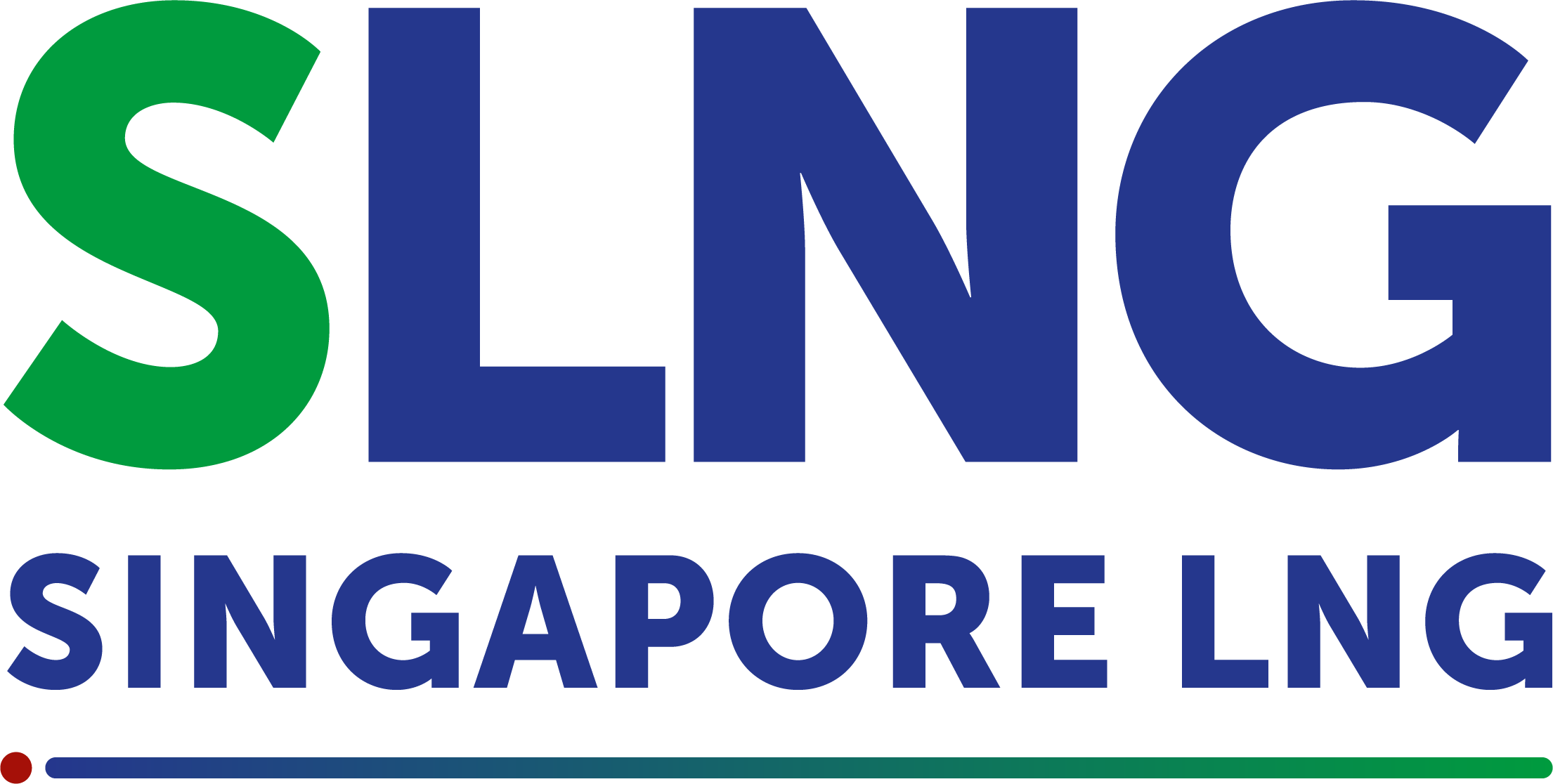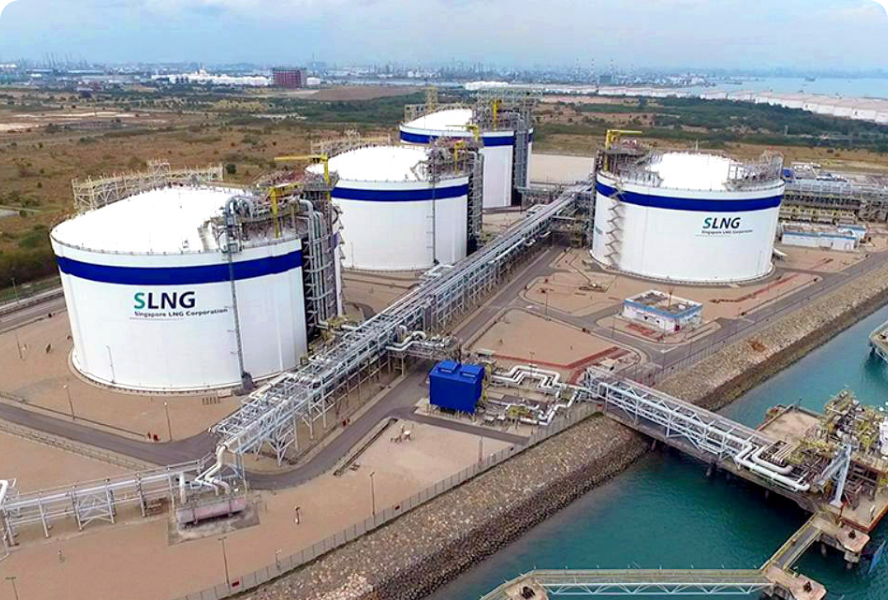LNG Terminal Will Diversify Energy Sources And Enhance Singapore's Energy Security
Singapore’s first liquefied natural gas (LNG) terminal will further enhance Singapore’s energy security as it offers geographical diversification of LNG imports, making us less susceptible to price and supply risks. The LNG terminal which will allow Singapore to import gas from countries all over the world will also help to supplement our rising energy demand when it comes on-stream in 2013. As a fuel source, LNG will play an important role in helping to address Singapore’s energy challenges of energy security, economic competitiveness and environmental sustainability.
Good progress made with construction of three tanks and jetties underway
Located on Jurong Island, the LNG terminal is about 80 per cent complete. The LNG terminal’s good progress was shared by Mr Neil McGregor, Chief Executive Officer of Singapore LNG Corporation Pte Ltd (SLNG) during a visit to the terminal’s 30-hectare site by Mr S Iswaran, Minister in the Prime Minister’s Office and Second Minister for Home Affairs and Trade & Industry. Mr McGregor added that since the terminal’s groundbreaking in March 2010, construction of key installations including the first two LNG storage tanks and the primary jetty are well underway.
The LNG terminal will have a throughput capacity of 3.5 million tonnes per annum (Mtpa) when it is operational in the second quarter of 2013. This capacity will increase to 6 Mtpa by the end of 2013 when additional jetties and regasification facilities are completed. The terminal’s third tank is targeted for completion by the first quarter of 2014. Each tank which is 53-metre high, can hold 180,000 cubic metres of LNG, big enough to fit three Boeing 747 aircraft stacked on top of one another. (Please refer to Annex A for more interesting facts and figures about the LNG terminal.)
Upcoming consultation for future LNG procurement framework
The current LNG aggregator for Singapore, BG Singapore Gas Marketing has sold about 2.65 Mtpa of LNG and is expected to reach 3 Mtpa by 2013. As BG has an exclusive licence to import LNG and sell regasified LNG in Singapore for up to 3 Mtpa of LNG or until the year 2023, whichever is earlier, a study is underway to explore several possible frameworks for future importation of LNG once BG’s contract ends.
To this, Mr Iswaran announced at the visit that the Energy Market Authority will be issuing a post-3Mtpa LNG import consultation paper to gather industry and public feedback in March 2012. Noting that the needs of consumers and the LNG terminal’s efficiency are key considerations for the framework, Mr Iswaran stressed that the eventual framework should allow Singapore to continue to access competitively-priced and reliable supplies of LNG.
When completed, the LNG terminal will contribute to the development of Singapore as a regional gas hub and is expected to create new job opportunities for Singaporeans in a significant and rapidly growing industry. (Please refer to Annex B for background to LNG in Singapore.)
End of Release
About Ministry of Trade and Industry (MTI)
The Ministry of Trade and Industry seeks to promote economic growth and create jobs through the development of industry sectors and international trade interests. Our strategies are derived from Singapore’s general philosophy of economic management: strong adherence to a free market economic system and active pursuit of outward-oriented economic policies. For more information on the ministry, please visit www.mti.gov.sg.
About the Energy Market Authority (EMA)
The Energy Market Authority (EMA) is a statutory board under the Ministry of Trade and Industry. Our main goals are to ensure a reliable and secure energy supply, promote effective competition in the energy market, and develop a dynamic energy sector in Singapore. Through our work, we seek to forge a progressive energy landscape for sustained growth. Please visit our website www.ema.gov.sg for more information.
About Singapore LNG Corporation Pte Ltd
Singapore LNG Corporation Pte. Ltd. is a company incorporated by the Energy Market Authority to own and develop Singapore’s first LNG import terminal. For more information on SLNG, please visit its website at www.slng.com.sg
Annex A
Interesting Facts and Figures about Singapore’s LNG Terminal
Terminal’s Key Specifications
- The terminal will comprise three tanks, three jetties and will have a throughput capacity of up to 6 million tonnes per annum (Mtpa).
LNG Tanks
- Each of the three LNG tanks being constructed is 53 metres high and 90 metres wide. Each tank, can hold 180,000 cubic metres of LNG, could fit three Boeing 747 aircraft stacked on top of one another within it.
- A total of 27,832 cubic meters of concrete, 5,032 tons of steel reinforcement bars and 3,681 tonnes of steel plate is used for each tank.
- There are 562 steel piles are driven for each tank’s foundation and each tank sits on an area of 6,358 square metres. This is equivalent to 14 basketball courts.
- Two additional layers of nickel steel plate and carbon steel plate line the inside of the one-metre thick concrete walls of each LNG tank.
- The roof of tanks 1 and 2, each weighing 1,200 tonnes, were first built at ground level and then raised to 53 metres high using compressed air. At a speed of about 200mm/minute, the raising of each roof took around 4 hours.
Pipes
- There is a total of 1,555 tonnes of piping in the pipe racks at the LNG terminal. When laid out straight, it is equivalent to the distance from Singapore to Malacca.
Throughput Capacity (Regasification)
- Regasification is the act of warming LNG from its liquid state to its gaseous state.
- The LNG terminal will have an initial regasification capacity of 3.5 Mtpa of LNG when operational in the second quarter 2013. This will increase to 6 Mtpa when the additional jetties and regasification facilities are completed by end of 2013.
People
- Currently, there about 1,400 people working on the LNG terminal construction site.
Annex B
Background of LNG in Singapore - Chronology of Events
On 7 August 2006, Mr Lim Hng Kiang, Minister for Trade and Industry announced that Singapore would build an LNG terminal to import LNG to diversify its sources of energy and to meet Singapore's rising future demand for energy.
On 4 September 2007, Mr S. Iswaran, then Minister of State for Trade and Industry, announced that the Energy Market Authority (EMA) would call a Request for Proposal (RFP) for interested parties to participate in the selection process as an LNG Aggregator. Interested parties were invited by EMA to submit their business concepts for the Aggregator role. PowerGas Ltd (PowerGas), a wholly-owned subsidiary of Singapore Power Limited, was then designated as the LNG terminal owner and operator.
On 18 April 2008, BG Singapore Gas Marketing Pte Ltd was appointed as the LNG Aggregator for Singapore. In this role, BG would aggregate demand for regasified LNG from all end-users in Singapore and procure LNG supply for up to three million tonnes per annum (Mtpa).
On 28 April 2008, PowerGas was appointed as the developer of the LNG terminal.
On 30 June 2009, Mr S Iswaran, then Senior Minister of State for Trade & Industry and Education announced that the Government would take over the development and ownership of the Singapore LNG terminal, as it was difficult to proceed with the project on a commercial basis. EMA subsequently formed a new company, Singapore LNG Corporation Pte Ltd (SLNG), to own the terminal and oversee its development.
On 8 February 2010, SLNG awarded the contract for the engineering, procurement and construction (EPC) of Singapore's LNG terminal to Samsung C&T Corporation (Samsung). Foster Wheeler Asia Pacific Pte Ltd (Foster Wheeler) was also appointed by SLNG as Project Management Consultant.
On 31 March 2010, a groundbreaking ceremony was held at Jurong Island for Singapore’s LNG terminal. Mr S Iswaran, then Senior Minister of State for Trade & Industry and Education announced that six generation companies have committed to an initial tranche of around 1.5 Mtpa of regasified LNG. The six companies - Senoko Energy, PowerSeraya, Tuas Power Generation, SembCorp Cogen, Keppel Merlimau Cogen and Island Power Company (now GMR Energy), entered into long-term gas purchase contracts with BG Singapore Gas Marketing Pte Ltd.
On 2 November 2010, Mr S Iswaran, then Senior Minister of State for Trade & Industry and Education announced the decision to proceed with the construction of a third LNG storage tank at the terminal. He also announced that the six generation companies have made firm commitments to purchase an increased volume of 2 Mtpa of regasified LNG.
On 21 January 2011, SLNG announced the award of the contract for the EPC of the third LNG storage tank to Samsung. The third 180,000 cubic metre LNG tank, in addition to the two similar sized tanks that are being built, will increase the terminal’s storage capacity to handle up to 6 Mtpa of throughput. This addition gives Singapore greater flexibility not just to meet its future gas needs, but also to pursue new business opportunities in the LNG market.
On 4 August 2011, the SLNG announced the award of the EPC contract for the Secondary Berth Project to Samsung. The project, which forms part of the S$1.7 billion overall Singapore LNG terminal project cost, comprises a secondary jetty designed to berth LNG ships with a cargo capacity ranging from 60,000 to 265,000 cubic metres (m3), and a tertiary jetty marine sub-structure designed for the future berthing of smaller LNG ships and barges with cargo capacity ranging from 10,000 to 40,000 m3. The Secondary Berth Project will give added flexibility and value to the range of LNG terminal services that SLNG can offer its customers in Singapore and regionally.
Download Full Press Release Here (272.24 KB)

